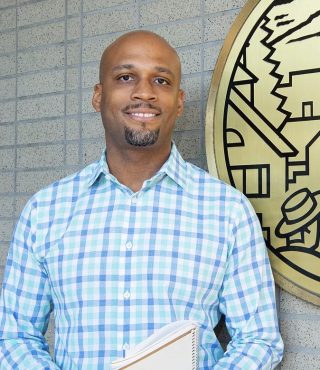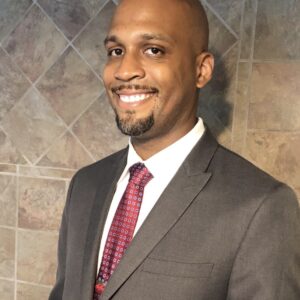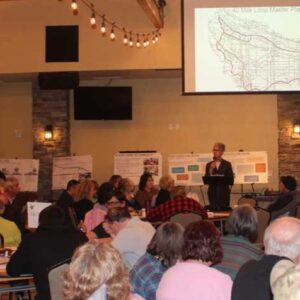“Climate change is not going to wait on any of us and we have to transform our system in a way that can meet our climate goals… I would love to take a billion dollars and put it into a community, rather than a freeway expansion.
— Ashton Simpson, Metro Council candidate
Ashton Simpson wants a seat on Metro Council.
Simpson, the current executive director of nonprofit Oregon Walks and former community organizer and US Air Force veteran, made the announcement Wednesday and already has a campaign website and several very notable endorsements. He’s vying for the District 1 seat that goes from 122nd east to Troutdale, and from the Columbia River south to Happy Valley.
Beyond his work at Oregon Walks, Simpson is very involved in transportation issues in the region. He’s a member of the Interstate Bridge Replacement Community Advisory Group and he sits on the Oregon Department of Transportation Region 1 Advisory Committee on Transportation.
I caught up with him on the phone yesterday. Our chat below has been slightly edited for brevity and clarity.
Jonathan Maus: Why are you running?
Ashton Simpson: I’m running because we have a whole region here that needs to be lifted up. Right now we need leadership that reflects the community. The current census data that we have now says East County is becoming is becoming more and more diverse. I want to make sure that as we are one planning and doing land-use issues that it is going to benefit the people who live here. Meaning, getting them back to work through family-wage, union labor jobs… and also being able to build up their own communities through community benefits agreements and things like that. Also I’m very passionate about our parks and green spaces. So I really want to make sure that we expand those in this region and close some of the gaps that exist in our trail system. And, as you know, always always always as a priority for me is climate and active transportation infrastructure — making sure folks can move around with the most basic needs by walking and rolling.
JM: I assume you heard Metro Councilor Juan Carlos Gonzalez say he would no longer support funding for freeway expansions without a commitment to orphan highways. Is that the kind of position we could expect from as Councilor Simpson?
AS: Absolutely. You know what? Climate change is not going to wait on any of us, and we have to transform our system in a way that can meet our climate goals. But also as Councilor Gonzales points out, I would love to take a billion dollars and put it into a community, rather than a freeway expansion.
JM: A few years ago Metro was forced to shelve a major trail project because people were afraid it would become filled with homeless encampments. I also hear regularly from people who have stopped using our regional paths because they are often blocked by trash and belongings and/or they fear for their safety due to the presence of people living on them. There has to be a way to make this situation better for everyone. Have you thought about this issue and is there anything you could bring to Metro that would help address it?
Advertisement
AS: I have no choice but to think about this and I see it everyday in my community. The campus at 122nd and Siskiyou, down on Marine Drive, which is also a part of our “regional biking highway” as I put it… We have to do better with housing. And from Metro’s point of view, we can definitely work with our jurisdictional partners to make sure that happens because that’s not that’s not something Metro can do on its own… I mean, you can focus on the trails, but then what about the people? And I’m always people-first. And I get it; people want to have access to those green spaces and things like that. Well first of all, let’s take care of the people who are living without shelter. Right? Like let’s do that first, and then let’s talk about closing those gaps. Because until we do that, nobody’s gonna feel safe, or want to ride on those, those paths without that level of level of comfort.
JM: How has your previous experience set you up for this next step?
AS: First of all, it’s all about collaboration. And in each of those roles I’ve had, I had to work with teams and with leaders in the community to find change. So for example 82nd Avenue, that took a lift from the legislature, took a lift from ODOT, from PBOT, and also took a lift from us as community activists and residents in the area. That collaboration piece is what I want to bring to the table working between these jurisdictions in this region and in this city, to make sure that it’s working right for the people.
JM: As you know, Metro doesn’t necessarily get into the business of designing streets, but they do hold a lot of the the budget pursestrings. Looking ahead are you ready to have that big conversation about another transportation funding package?
AS: Top priority. Top priority. I put a lot of work into the last measure. And from being on a local investment team, to really promoting it and getting it out there to the community through various educational events, You know, this time around we’ve got to pass it. Because guess what? Our community was set back to square zero, while other communities, you know, continue to get build-outs. Things are happening slowly. PBOT is doing what they can do with the funds that they have. But at the end of the day, it’s going to take a big lift from a measure like that.
JM: Anything else you want the community to know about you and your campaign?
AS: Absolutely I want them to know that I’m not only going to fight for just all the things I want, I’m going to be specific. I want to talk about protected bike lanes in East Portland and what that looks like. I mean, we got the start of it on Halsey here with a 30 mph speed limit reduction. Now we need some enforcement and some road design. Part of that road design means we have to have separate modes of transportation, or have the modes of transportation separated out so we have safe places for people to walk and bike. I especially want to center in this in this race our seniors, our youth, and people with physical and mental disabilities. Because if we design things with with those folks centered, everybody else will benefit. And that’s that’s how I roll. I’ve learned that from my career in the Air Force to my time working in construction, that has always been the focal point. It’s about making sure folks — the most vulnerable and a disadvantaged — can have that ease of access and a comfortable mobility.
Learn more about Ashton Simpson at AshtonforMetro.com.
— Jonathan Maus: (503) 706-8804, @jonathan_maus on Twitter and jonathan@bikeportland.org
— Get our headlines delivered to your inbox.
— Support this independent community media outlet with a one-time contribution or monthly subscription.







Thanks for reading.
BikePortland has served this community with independent community journalism since 2005. We rely on subscriptions from readers like you to survive. Your financial support is vital in keeping this valuable resource alive and well.
Please subscribe today to strengthen and expand our work.
The enforcement topic was left on the table, unfortunately. I think that’s a “black box” for anyone observing. How will that gap get closed? Would love to hear thoughts on that from Ashton.
On the plus side, he said two things that indicated he is interested in coalition building. Which is really how you get things done.
Yep, definitely need ENFORCEMENT! I want to hear about that from any and all candidates.
Unfortunately, his plan to make bike paths open and safe for all sounds like no plan at all. Very disappointing. More of the same inaction we have had that has made the trails off limits to most cyclists.
I think his assessment is very in line with reality. Just relocating the campers to new digs doesn’t solve the problem. We (society) will continue to suffer this outrageous condition, as long as we continue to kick the can down the road. And I think Ashton expresses a sense of awareness for this, which I support. Let’s get to the root cause, not keep slapping band-aids down.
I respect and understand and appreciate Ashton’s response to this, but I think we need a more middle ground. IMO Ashton might be saying what all local leaders and would-be electeds are saying because it’s the safest thing to say without unleashing a lot of pushback from some folks. Yes he absolutely believes in what he’s saying, but I think Portland in general has to do a better job of staying true to the values and vision of what we need to do long-term, while embracing the messy challenges of what we must do in the short term. IMO the current status of waiting on shorter-term solution until the long term solutions are in place and working is untenable. Why don’t local leaders talk about how to make the current situation better? Isn’t the current situation bad for everyone? And if you think it’s bad for everyone, shouldn’t we discuss and debate how we can make it better? For instance, why can’t a local elected or leader acknowledge that the de facto closure of many key regional paths due to trash and encampments needs to be addressed. Seems to me we should expect our gov’t to keep the paths much cleaner and they can go out and encourage folks to try harder to keep their tents and belongings off of the path. They could leave posters/signs saying that the path is important and to please keep it clear. That to me seems like a reasonable approach.
While I am giving him the benefit of the doubt, this is a very real specter. He could be pandering for votes. Maybe I’m too naive or generous with my benefit of the doubt?
I realize that Wheeler had to be humbled by this, given that he originally ran on the “fix the homeless problem” platform. Then was met by overwhelming resistance. But I’m still upset he left that on the table.
What I feel will happen is, private organizations will fill that gap. There’s already at least one that has cropped up to do so, but the organization lacks transparency. People for Portland sounds nice on the surface, but what are their goals and where is the money coming from? Inaction by the real leaders of this city will make privately funded organizations more palatable for a desperate populace. One that’s less likely to ask the piper where the houseless will go, just to get rid of them.
I’m jaded and I think that signs would be ignored or vandalized.
What makes the most sense for me is to have a dedicated department, trained to respond to houseless people directly. Didn’t PDX put this on the parks department? That may be sub-optimal, and it allows the city to double dip with their budget.
Assuming this is an efficacious endeavor, I’d ask these teams take up a presence on the paths. They can observe, educate and correct the situation through direct action. First hand intervention by non violent workers presents a way forward. Maybe even cyclists could be hired to patrol the paths? Assuming they are vetted, of course.
But even then, what’s the next step? There needs to be a feasible alternative to camping on a MUP. I’m really impressed with the Water ave camp. More of those are needed I think. Just letting people make up their own sprawling “tarp towns” will not lead us to where we want to be. Nor will the perpetual cycle of rousting the campers from one unsanctioned spot to another.
obviously signs/posters wouldn’t fix everything but that’s not my point. My point is… It doesn’t feel like anyone in a position of power and influence who has credibility and trust is saying anything or doing anything beyond focusing on the longer-term goal of getting everyone into shelter. At least by going out there and attempting an educational effort, mixed with more focus on cleaning up the paths, they would be sending a signal that they are doing SOMETHING beyond the important work of building shelters and investing in the long-term. That’s my point.
I think were on the same page. Some action is needed to demonstrate the commitment to change the situation.
Jonathan, I think I agree with you. I wouldn’t say some signs are a “middle ground” though. If one side of the street was our current paradigm where unhoused folks can do anything they want and the other side of the street is hiring storm troopers to arrest and incarcerate them I would say a “middle ground” is Yuko’s comment:
“We need urgent deployment of temporary shelter beds and regulated, supervised camping sites for risk reduction. The current situation is inhumane” Then we will need to ban public camping. It’s compassionate to both the housed and the unhoused.
.
Mr. Simpson’s bike path answer is just more of the current ineffective approach to homelessness. When will politicians disabuse themselves of the notion that the Portland region will alone be able to build its way out of homelessnes for the entire region’s homeless? It is simply unrealistic. We need urgent deployment of temporary shelter beds and regulated, supervised camping sites for risk reduction. The current situation is inhumane.
More of the same while we wait decades and decades for the pipe dream of permanent housing for all is not compassionate, neither to the unhoused or the housed.
I don’t feel guilty one iota saying that I should be able to use my local bike paths without having them blocked with garbage and abandoned autos or fearing for my safety.
https://www.oregonlive.com/opinion/2021/08/opinion-faster-action-needed-on-homelessness-crisis-starting-with-5-critical-steps.html
I wish politicians would address how blocked, unusable, unsafe bike paths negatively affects our collective carbon footprint instead of just focusing on new freeway construction. If people don’t feel safe riding their bikes they’re going to drive. Simple as that.
I’ve spoken with folks who have greatly reduced their cycling or quit all together because of safety concerns. One of my neighbors had a car speeding and honking behind them on the marine drive path. They said they’ll never ride there again.
My boss asked on a Zoom call the other day, “does anyone know what ‘rolling coal’ is?” I said, yes, of course I do. I ride a bike!
While I agree, I think that unsafe infrastructure and dangerous driving is a bigger deterrent to cycling than homeless folks or encampments on or around multi use paths. I’m a small woman who lives and rides in East Portland, and while I don’t enjoy picking my way through some of the gnarlier stretches of the 205 path (and do avoid certain parts of it and other paths altogether), I’m much more scared of the drivers on 122nd or far out on NE Halsey.
JP,
I think we need to focus on both things, the homeless blocking bike paths/making them unsafe AND unsafe infrastructure/dangerous driving.
The plight of our houseless neighbors and friends is a far, far more important social issue than the discomfort of a tiny population of people who bike on multi-use paths, ATMO. And this is especially the case given that toxic freeway-adjacent multi-use paths are terrible transportation cycling infrastructure.
Soren, Oh please. This type of talk is so 2020.
The prices of twee homes and, now, rent continues to rocket up. Apparently, the human consequences of capitalist urbanism are also so 2021…
Oh please Soren. Most of this mess has nothing to do with the cost of rent and you know it.
“Nothing to do with the cost of rent”
In my experience, this kind of evidence-free absolutism is often associated with bias.
https://projecteuclid.org/journals/annals-of-applied-statistics/volume-15/issue-2/Inflection-points-in-community-level-homeless-rates/10.1214/20-AOAS1414.short?tab=ArticleLink